Leonard Bernstein and the Jewish Cultural Ascendency — PART 1
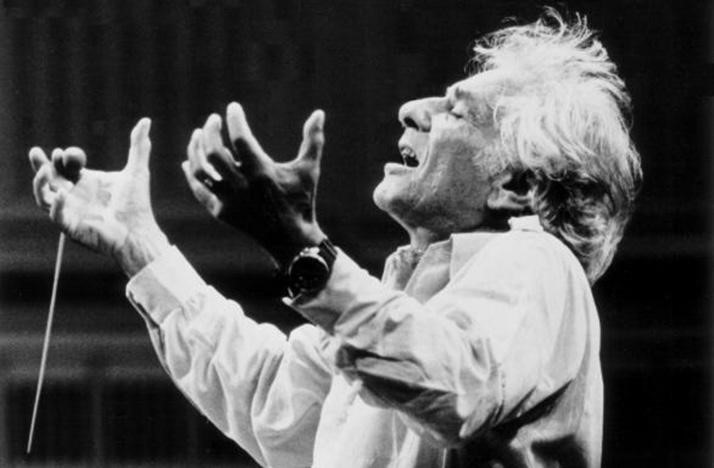
Introduction
2018 marks the centenary of the birth of Jewish-American conductor, pianist, composer and teacher Leonard Bernstein. This milestone has seen a global bonanza of 2,500 concerts, programs, exhibitions and theatrical productions. Bernstein features prominently in the pantheon of “Jewish geniuses” as designated by the West’s Jewish-dominated cultural and intellectual establishment. Bernstein’s centenary year inevitably yielded hagiography: for his Jewish biographer Allen Shawn, he was not just a “genius” but “a powerful cultural and political voice and symbol, transcending all categories.”[1] Mark Horowitz, curator of an exhibition at Philadelphia’s Jewish museum celebrating Bernstein’s “pride of tribe,” fully endorses this view, while for the Jewish music writer for the New Yorker, Alex Ross, Bernstein remains “American music’s dominant figure.”
Bernstein lived during the heyday of the recording industry, at the dawn of the television era and of video recording. He left behind what is possibly the most extensive documentation in recordings, films, and on paper of any musician in history. His archive at the Library of Congress already lists some 400,000 items.[2] During the 1950s and 1960s Bernstein was not only the best known of all American classical musicians; his fame rivalled that of Elvis Presley or Marilyn Monroe. Attitudes to Bernstein varied dramatically during his lifetime, and many responded negatively to the fact he was so visible, so outspoken, so dramatic, and so politically active on the left.
Famous for his flamboyantly extroverted temperament, Bernstein was a “personality on such a big scale that he would naturally manage to offend many people along the way. … His self-regard and need for attention were also, to be sure, extreme.”[3] Bernstein’s brash self-confidence and monstrous ego incurred the enmity of many of those he encountered. He “loved to be the center of attention, even if it meant being obnoxious” observed a fellow student at the Curtis School of Music who noted that his “extroversion was extreme.”[4] John Rockwell, writing for the New York Times in 1986, observed that “It is quite a remarkable personality, for better and for worse, the defines every aspect of his near-manic existence. There are those who still find him inherently annoying — when he shoots off what he likes to call his ‘big Jewish mouth,’ when he prances and gyrates on the podium, when he seems to squander his compositional gifts in flashy trivia or overwrought excess.”[5] Bernstein’s own children pointed out his unsurpassed ability to become emotional on his own behalf, to “move himself.”[6]
Bernstein’s unusual, extremely emotional, visual presentation was his trademark as a conductor. He conducted with his entire body in a style that led to much criticism and derision over the years. German composer Gunther Schuller, for example, observed that Bernstein was “one of the world’s most histrionic and exhibitionistic conductors.” Schuller saw Bernstein as a musician with “very little discipline and no shame,” whose interpretation of Brahms’ First Symphony contained “too much of an ‘oy-vey’ Weltschmerz to be bearable.”[7]
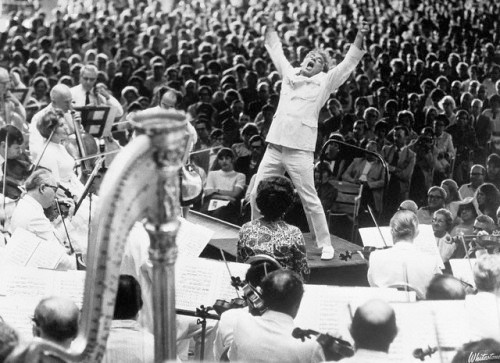
Bernstein conducting Mahler with the Boston Symphony Orchestra
Bernstein’s conducting style was modelled on Dimitri Mitropoulos, the flamboyant Greek conductor he met while at Harvard in 1937. Under this influence, the art of conducting turned into what Bernstein defined as “an erotic act” involving “a love affair in which you [the conductor] and a body are breathing together, pulsing together, lifting and sinking together. I’m making this sound too lurid or sexual? It is sort of sexual, but it’s with a hundred people.”[8] Perhaps not coincidentally, Bernstein, a promiscuous homosexual, was seduced by the equally wanton Mitropoulos.
Aside from Mitropoulos, Bernstein was mentored and promoted by a succession of Jewish conductors and composers. These included Fritz Reiner and Serge Koussevitzky, the conductor of the Boston Symphony Orchestra and Bernstein’s teacher at the Berkshire Music Center at Tanglewood, Massachusetts. In Koussevitzky, Bernstein “found a champion and father figure” while for the older conductor “it was the discovery of a surrogate son and potential successor.”[9] Koussevitzky, a Jew who converted to Russian Orthodoxy to advance his career, hoped Bernstein would eventually succeed him as conductor of the Boston Symphony, but worried his homosexual tendencies (which he called “pederastical”) and his Jewish name would harm his chances.[10]
Bernstein was appointed assistant conductor at Tanglewood in 1942 where he was known to enter a classroom and “hug, touch, and embrace everyone in sight.” There he worked closely with the composer Aaron Copland who, while 18 years his senior, as a Jewish homosexual communist had much in common with Bernstein, and quickly became more than just a father figure to the “Boston boychik” (as the young Bernstein was known). Letters between them “show that they had briefly been lovers, with Bernstein recalling the time he and Copland had spent together: ‘I’ve never felt about anyone before as I do about you, completely at ease, and always comforted by you. This is not a love letter, but I’m quite mad about you.’”[11] Copland, as promiscuous as Bernstein, though more discrete, was involved in a “sometimes bewildering series of personal relationships with younger men.”[12] Within musical circles at Tanglewood, Copland was “assumed to show too much favor to young gay and/or Jewish musician-acolytes.”[13]
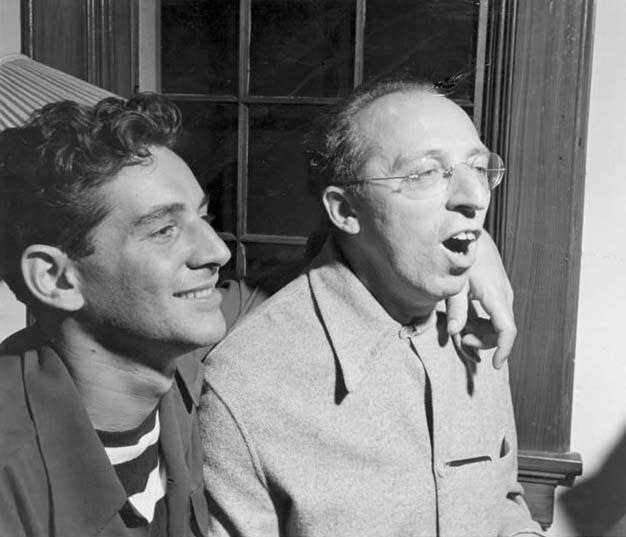
Bernstein with Aaron Copland
Another Jewish homosexual communist who bonded with, mentored and promoted the young Leonard Bernstein was the composer Marc Blitzstein. It was Bernstein’s association and collaboration with Blitzstein that first “gave rise to notes on the young musician and his ‘left-wing associations’ in a folder at the Federal Bureau of Investigation.”[14] The FBI were notified by an informant that “80% of the faculty of the Tanglewood group are Communists.”[15]
Conductor of the New York Philharmonic
On November 14, 1943, a twenty-five-year-old Bernstein stepped in for an ill Bruno Walter at a New York Philharmonic concert at Carnegie Hall — an event that effectively launched his conducting career. The press, alerted beforehand, “went wild with praise.” His debut made the front page of The New York Times which gave ecstatic coverage of the event. Bernstein was aggressively promoted by this and other Jewish-controlled media organs: in the two weeks after his debut with the New York Philharmonic he was interviewed and promoted by Life, Time, Newsweek, Pic, Look, Vogue, PM, Pix, Harper’s Bazaar, the New York Times, the Herald Tribune, the Jewish Forward, the Jewish Telegraphic Agency, Jewish Day, the New York News, the New York Post, and The New Yorker.[16]
In 1958 Bernstein displaced Mitropoulos as the youngest ever music director of the New York Philharmonic, a position he held until his retirement in 1969. Bernstein’s rise to this exalted position coincided with the Jewish seizure of the commanding heights of American culture. Allen Ellenzweig, writing for Tablet, notes how: “After World War II, it seemed as if American culture high and low had been taken over by the Jews: Danny Kaye in the movies, George Burns and Milton Berle on television, Norman Mailer and Saul Bellow in literature, Arthur Miller in theatre, Jerome Robbins in ballet and on Broadway, Leonard Bernstein on Broadway and in the concert hall.”[17]
In the first half of the twentieth century WASPs still controlled American culture and the American people were generally more ethnocentric and aware of (and antagonistic to) the subversive Jewish influence on American society. The Jewish challenge to the cultural supremacy of the WASP elite (and America’s once powerful Catholic lobby) might, in the absence of active Jewish efforts to prevent it, led to a backlash against undue Jewish influence on American culture and mores. Efforts to forestall such a backlash included the novel Gentleman’s Agreement by Laura Hobson (born Zametkin), and its Academy Award winning film adaptation released in 1947, which decried the “unspoken snobberies of the American suburbs that allowed for ‘restricted’ hotels, country clubs, and golf courses and signaled that Jewishness remained a problematic social marker.”[18]
The Jewish domination of the film and television industries around this time transformed the American cultural landscape. Neal Gabler has described how the Jews that ran Hollywood “colonized the American imagination. … Ultimately American values came to be defined largely by the movies the Jews made. Ultimately, by creating their idealized America on the screen, the Jews reinvented the country in the image of their fiction.”[19] By the mid-1960s the Jews of Hollywood had usurped the WASP cultural elite and became more explicit in their Jewish identification and sympathies — together with their antipathy for the traditional people and culture of the United States. Explicitly Jewish themes began to regularly appear in films and were invariably portrayed in a positive light. The Jewish film director David Mamet makes the unambiguous point that “Hollywood movies are profoundly, genetically Judaic; the product, via the minds of their creators, of certain distinctive racial traits that arose in the ghettos of Eastern Europe and transported themselves to Beverly Hills.”[20]
Bernstein’s political radicalism
This Jewish takeover of American culture (high and low) was accompanied by a dramatic shift in political sensibilities of the cultural elite. Bernstein had grown up in a Jewish home in Massachusetts where his father, a Jewish immigrant from an ultra-orthodox shtetl town in the Ukraine, held forth on “subjects running from Talmudic meditations and the history of the Jewish people from biblical times to their plight under Nazi power in Europe.”[21] In Jewish homes in the 1930s, talk frequently centered on “the condition of American Jewry and devotion to President Roosevelt, whom many Jews saw as a bulwark against foreign and domestic fascists such as Father Coughlin, whose broadcasts reached across the nation, and other anti-Semites.”[22]
Bernstein pursued a musical career against the wishes of his father. His paternal grandfather was the last in a long line of rabbis in the family tree. While breaking this family tradition, Bernstein’s businessman father nevertheless remained “devout, intense, rule-bound, sometimes harsh” whose “principle reading matter and point of reference for all things, worldly and unworldly, was the Talmud.”[23] His personality was marked by “consuming ambition and penny-pinching.”[24]
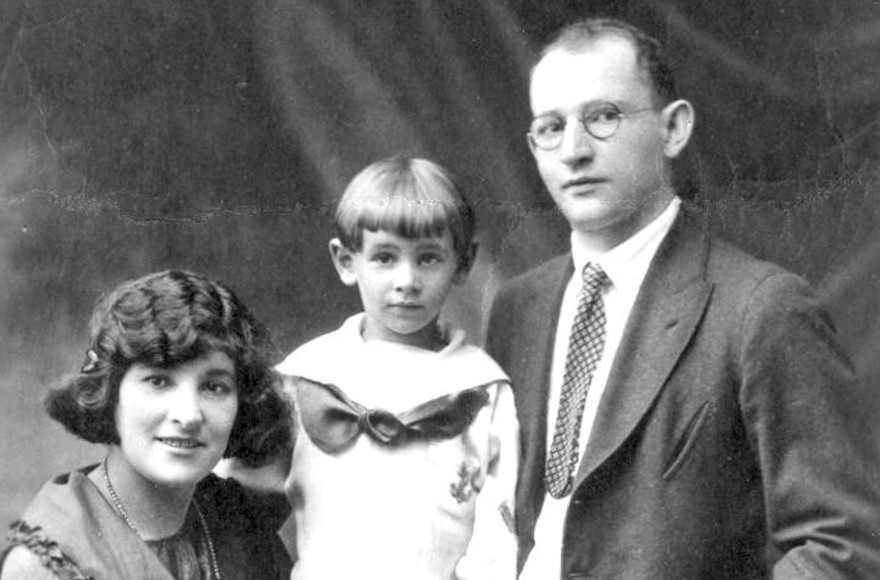
Bernstein with father Sam and mother Jennie
Beginning in his young adulthood, Bernstein the younger joined and openly advocated for various communist front groups, beginning with the John Reed Society while an undergraduate at Harvard in the 1930s. This inevitably attracted the attention of the FBI, as did his support for organizations opposing Franco’s Spain, his appearances at rallies and functions with known communists Paul Robeson, Dashiell Hammett, Billie Holliday, Rockwell Kent, and Lena Horne, as well as his membership in the Council on African Affairs, the National Negro Congress, and the National Council of American-Soviet Friendship. In December 1946, Bernstein’s FBI file (which would ultimately run to 800 pages) records a Musicians’ Union informant’s declaration that he was “a communist.”[25]
This claim is bolstered by Bernstein’s open support for the Jewish communist composer Hanns Eisler when Eisler was threatened with deportation from the United States as a threat to national security. A committed Marxist, Eisler left Germany following Hitler’s ascent to power, eventually settling in Hollywood where he was nominated for Oscars for writing the music for Fritz Lang’s film Hangmen Also Die (1942) and None but the Lonely Heart (1944). In 1947, Eisler appeared before the House Un-American Activities Committee (HUAC) and, despite the intercession of Bernstein, Albert Einstein and Aaron Copland, was deported to East Germany in 1948 where he remained for the rest of his life, writing music for the totalitarian state (including its national anthem, and the Comintern anthem). Instead of reproaching Eisler for his ardent commitment to a regime and an ideology that destroyed millions of lives, Jewish commentators invariably portray him as the innocent victim of the anti-Semitism of the Third Reich, the HUAC hearings, and the Hollywood blacklist.
As was typical for a generation of Russian Jewish immigrants and their offspring, Bernstein’s political radicalism existed alongside a “staunchly pro-Zionist” outlook. In April 1947, he paid an emotional first visit to Palestine — then a British protectorate with a one-third Jewish population. He arrived in the middle of a tense conflict between rival Jewish groups over how best to achieve the independent Jewish state mandated by the Balfour Declaration. The terrorist Irgun, led by Menachem Begin, battled with those seeking a political solution. There he bonded with members of the Palestine Symphony Orchestra (all Jewish despite the name) and conducted a concert in Tel Aviv consisting of his Jeremiah Symphony, the Ravel Piano Concerto, and Schumann’s Second Symphony. The audience responded “with an overwhelming ovation and tears. With his ability to speak Hebrew, his affinity for the place and its people, and the passionate bond he had created with the members of the orchestra, Bernstein felt himself deeply at home.”[26] Bernstein would conduct the orchestra, later renamed the Israel Symphony Orchestra, frequently without fee for the rest of his life.
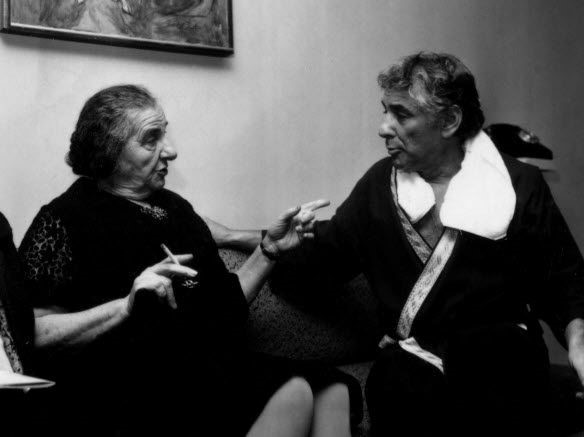
Leonard Bernstein with Israeli Prime Minister Golda Meir
Bernstein was blacklisted by CBS radio and television in 1950, the year he was listed as a dangerous subversive in the pamphlet Red Channels: The Report of Communist Influence in Radio and Television which listed the names of 151 writers, directors and performers who had been members of radical organizations before World War II — over one-third of whom were Jewish. In June that year he was “banned from official State Department functions overseas” as a “loyalty and security risk.” In 1951 his name was placed on a list of those prominent individuals to be placed in detention facilities in the event of a “national emergency.” Shawn observes how this “put him at risk of scrutiny by the House Un-American Activities Committee (HUAC) and to attacks by the anti-communist crusader Senator Joseph McCarthy.”[27] Bernstein had good reason to suspect that, if he wasn’t careful, his entire conducting career and all that went with it would be in jeopardy.
Despite the threat, Bernstein participated in a trip to Washington by delegates from the film and Broadway communities in support of the “Hollywood Ten” screenwriters who had opposed testifying before HUAC. The members of the Hollywood Ten were subsequently cited for contempt by Congress and fired by the studios, and the Hollywood blacklist became official. A prime source of the animus against Hollywood as identified by one member of the House Committee, Congressman John Rankin from Mississippi, was “the large number of Jews eminent in the film industry. … In Rankin’s mind, to call a Jew a Communist was a tautology.”[28]
The “Homintern”
Worried his homosexual activities would prevent his landing a major conducting appointment in the conservative world of classical music, Bernstein married actress Felicia Cohn Montealgre at the Temple Mishkan Tefila in September 1951. They married on the clear understanding that so long as Leonard did not embarrass Felicia publicly, he was free to pursue his homosexual affairs. That the marriage yielded three children led some to assume Bernstein was bisexual. According to one his collaborators on West Side Story, however, “Bernstein was simply ‘a gay man who got married. He wasn’t conflicted about his sexual orientation at all. He was just gay.’ As was customary at that time, Bernstein appeared a devoted husband and father in the public eye, while carrying on a promiscuous homosexual life behind the scenes.”[29]
Bernstein’s marriage was a response to the “Lavender Scare” that coincided with the anti-communist movement of the 1940s and 1950s, when homosexuals were targeted as potential security risks. Thousands of civil servants, uniformed service members, and teachers across the country were fired from their jobs as risks to national security because of public perceptions of moral turpitude and because they could be blackmailed by the Soviet Union. In 1950, the head of the Republican National Committee warned that “the sexual perverts who have infiltrated our government in recent years” were “as dangerous as the actual communists.” Human Events, a newsletter read in power circles in Washington, D.C., declared in 1952: “By the very nature of their vice,” homosexuals “belong to a sinister, mysterious, and efficient international.” A 1951 article in H.L. Mencken’s American Mercury insisted publishing was under homosexual control, producing a literary culture that was “chic, artificial, and possibly effeminate,” thereby abetting a “gradual corruption of all aspects of American culture.”[30]
As concern about international communism often centered on the “Comintern,” the Soviet-sponsored Communist International with representatives around the globe, concern about homosexuals led to an equivalent coinage: the “Homintern.” The “Lavender Scare” impacted on the coterie of homosexual Jews clustered around Bernstein during the 1940s and 1950s, including David Diamond, Aaron Copland and Jerome Robbins. A friend of Bernstein noted how during this time in New York, “They all went to bed with each other but was all very casual. Like a Turkish bath. Anyone who showed up.” Jewish leftist homosexuals like Aaron Copland, Leonard Bernstein, Jerome Robbins, Arthur Laurents, and Lincoln Kirstein developed “mixed communal and professional networks to reach cultural prominence” and “Within cosmopolitan circles, all were discreetly known as transgressing the heterosexual norms of the postwar period.”[31]
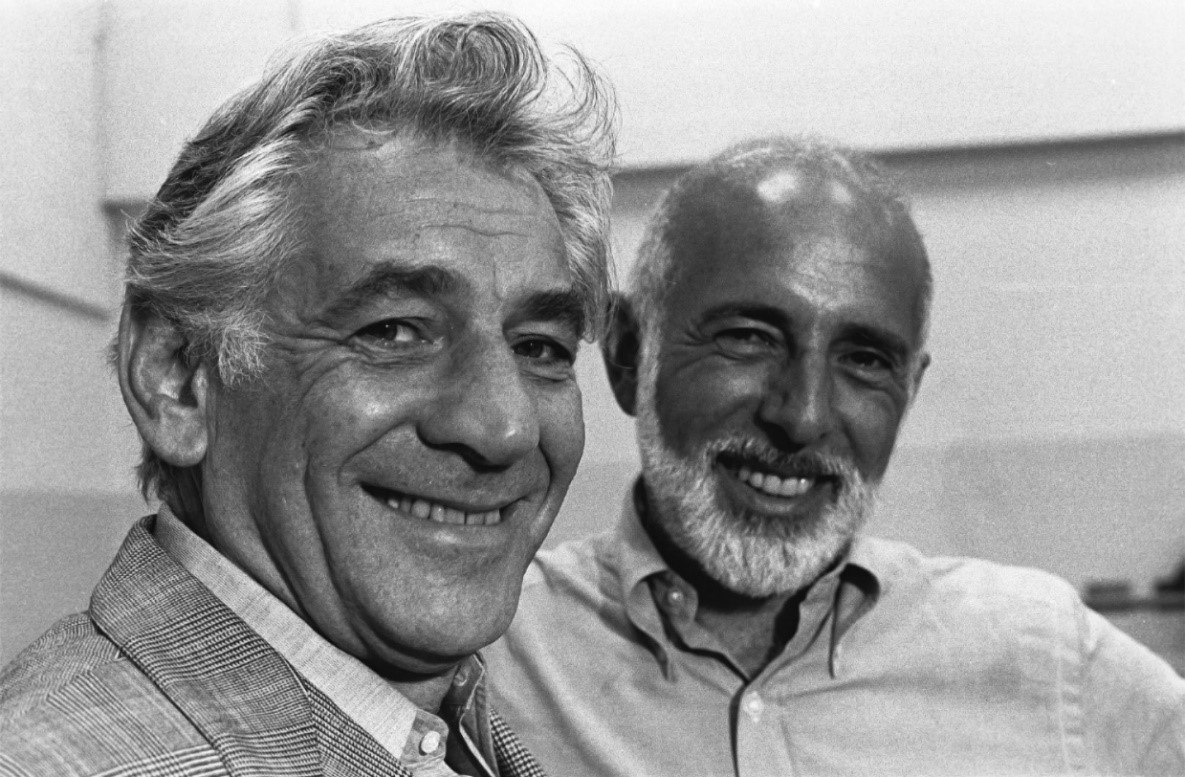
Leonard Bernstein and Jerome Robbins
Bernstein bonded with Jerome Robbins, a choreographer with the Ballet Theatre in New York. Born to Russian and Polish Jewish immigrants, Robbins (Rabinowitz) had become “a member of the (then legal) Communist Party in 1943.”[32] Bernstein and Robbins collaborated to produce On the Town in 1945, a show combining elements of classical, jazz, boogie-woogie and blues, which was “the first racially integrated musical on Broadway, starring a Japanese-American, Sono Osato as the all-American girl Miss Turnstiles. On the Town contained pioneering multicultural and race-mixing propaganda which included Black and White dancers clasping hands while singing “New York, New York, a helluva town” two decades before a White woman touching a Black man’s arm on television triggered a scandal. The show also promoted feminism, celebrating “the modern American woman” who was “confident, employed, and sexually bold.”[33]
Off the Blacklist
In July 1953 the U.S. Passport Office refused to renew Bernstein’s passport due to the extensive record compiled by the FBI on his radical political affiliations. Desperate to travel to Italy to make his conducting debut at La Scala opera house in Milan, he hired a lawyer known for clearing political reputations—a lawyer who had once been on the side of the investigators. The result was
a humiliating exoneration that must have both relieved him and crushed his self-respect. The long affidavit he signed made light of all the times he had lent his name to a cause or appeared at a function, saying that he had endorsed letters and petitions casually, without knowing what they contained. He admitted that he was mistaken not to have immediately “made a public disavowal” of the associations implied by photos seen in Life magazine or portrayed in the pages of Red Channels. He pronounced himself a “foe of communism.”[34]
Signing the affidavit made a mockery of his contempt for the investigations, which he regarded as “a farce” and “part of a strategy to undermine support for legitimate revolutions abroad.”[35] The affidavit made possible his trip to Milan and, after he had given additional assurances, cleared the way for his participation as composer in the film On the Waterfront, written by Budd Schulberg, directed by Elia Kazan, and featuring Lee J. Cobb — each a HUAC informer.
These informants to HUAC were certainly not alone: the film director Robert Rossen (born Rosen) explained to the committee in 1953 why he had joined the Communist Party in the 1930s and remained a member “until revelations of Soviet anti-Semitism disillusioned him. He then named names. Within short order, he was off the blacklist.”[36] Bernstein’s friend and collaborator Jerome Robbins also named names in testimony to HUAC in 1953 — professionally dooming colleagues he had briefly known in a “theatrical transient group” called the Communist Political Association. Robbins said he joined under the naïve impression that “the Russian Communists were against fascism and anti-Semitism and in favor of artistic freedom.”[37]
With his work for On the Waterfront, Bernstein’s rehabilitation commenced. At the same time his humiliating backdown “fueled his anger in future decades against right-wing extremism and abuses of power.”[38] In 1953, Lillian Hellman, another Jewish communist, approached Bernstein about composing a musical theatre work based on Voltaire’s satirical novella Candide. Hellman was especially taken with a scene from the book set in Lisbon during the Inquisition, which gave her “a particularly ripe opportunity for satirizing the activities of HUAC.”[39]
West Side Story
Bernstein’s most popular and culturally significant work is undoubtedly West Side Story (1957) created in collaboration with three other Jews, Arthur Laurents (librettist), Stephen Sondheim (lyricist), and Jerome Robbins (director and choreographer). Robbins had introduced Bernstein to Laurents, whose 1945 Broadway play Home of the Brave, “dealt with anti-Semitism in an army unit during World War Two and had brought Bernstein to tears.”[40]
Many regard West Side Story as the highest peak the Broadway musical has ever attained. Its popularity only really took off, however, with the film version of 1961. West Side Story was originally conceived by Robbins as a story of Jewish-Catholic gang rivalry focusing on conflict during Easter/Passover between an Italian Catholic Greenwich Village family and a Jewish family living on the Lower East Side of Manhattan. In Laurents’ first draft — called “East Side Story” — the Maria character (originally called “Tante,” the Yiddish word for aunt) was a Holocaust survivor who had emigrated from Israel to America. The conflict centered on the anti-Semitism of the (Catholic) Jets and the justified resentment of the Jewish Emeralds.
As Bernstein wrote in his diary in late 1948: “Jerry R. called today with a noble idea: a modern version of Romeo and Juliet set in slums at the coincidence of Easter-Passover celebrations. Feelings run high between Jews and Catholics. Former: Capulets, latter: Montagues. Juliet is Jewish. Friar Lawrence is the neighborhood druggist. Street brawls, double death — it all fits.”[41] Clues as to the original scheme for the show are captured in Robbins’ original headings which include “Hideout (initiation: Beating up Jews)” and Bernstein’s annotations, which include “Ball or Seder or Motza’e Shabbat” and “Romeo’s death with Tante.” Bernstein even suggested including “a song on racism called ‘It’s the Jews.’”[42]
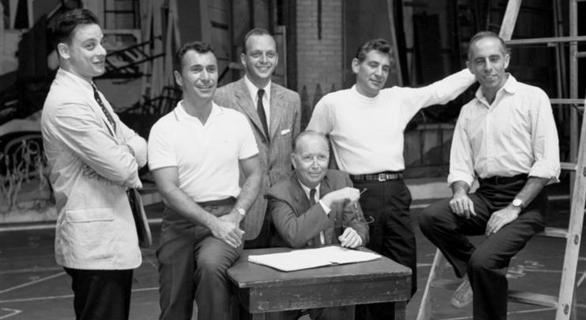
The Jewish creators of West Side Story Stephen Sondheim (far left), Arthur Laurents (second from left), Leonard Bernstein (second from right) and Jerome Robbins (far right)
Ultimately, the musical that became West Side Story drew upon gang violence in New York and Chicago then making headlines. Despite the changed ethnicities of the protagonists, the show remained, for its creators, an unabashed vehicle for Jewish ethnic activism: promoting, most fundamentally, changed ideas what it meant to be an American. Two star-crossed lovers, Tony and Maria, find themselves caught between the rival street gangs: The Jets, a group of Whites who consider themselves the true Americans, and the Sharks, first generation immigrants from Puerto Rico. The musical’s creators “projected Jewish otherness onto the Sharks, seeking recognition as full Americans by the Jets.”[43] Though the Jewish gang originally contemplated for “East Side Story” ultimately became the Sharks, “the gang retained an inherent Israeli characteristic: a readiness to ‘die defending their turf.’”[44] Librettist Arthur Laurents declared “We’re Jews. … West Side can be said to be informed by our political and sociological viewpoint.”[45]
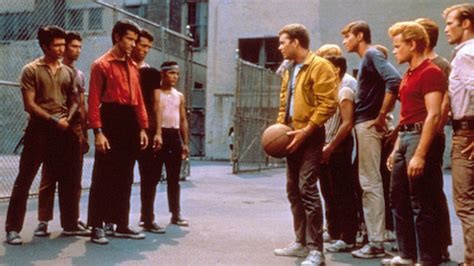
Scene from the 1961 movie version of West Side Story
Earlier this year, Jewish director Stephen Spielberg announced plans to remake West Side Story. Spielberg’s frequent collaborator, the Jewish playwright Tony Kushner, will write the script. Kushner openly declared himself: “a big believer in identity politics and political correctness. Why shouldn’t we want to be politically correct, if by correct you mean not toeing the party line but toeing the line of history, being on the right side of history, being moral and ethical?”[46] Writing for Tablet, Rachel Shukert wondered whether Spielberg and Kushner will merely be “content to explore these themes through the distance of the past” or whether they contemporize and deploy them as part of the Jewish crusade against President Trump: “Will we see gangs of MAGA-hatted bullies” she asks, “snapping their fingers dancing in the streets as they attempt to terrorize undocumented immigrants and DACA recipients?” According to Shukert, the Jets, like the White Americans who support Trump, “never really accept the Sharks,” while at the time of West Side Story’s premiere in 1957, “somewhere, far from the West Side, in a leafy upper-middle class suburb of Queens, a bratty little blond boy [Donald Trump] was already planning never to rent to them.”[47]

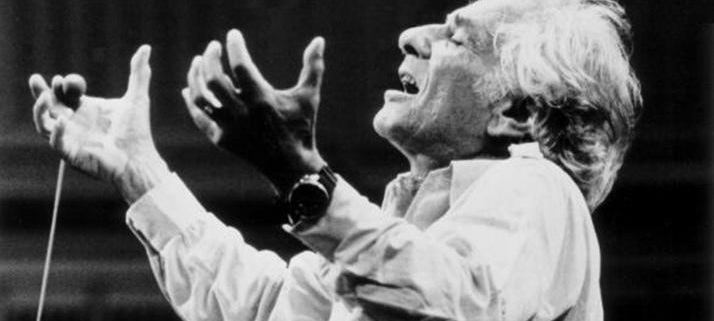




Comments are closed.